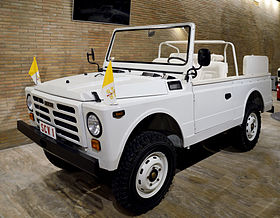
The inline-six engine is a piston engine with six cylinders arranged in a straight line along the crankshaft. A straight-six engine has perfect primary and secondary engine balance, resulting in fewer vibrations than other designs of six or fewer cylinders.

The V6 PRV engine is an automobile petrol V6 engine that was developed jointly by Peugeot, Renault and Volvo Cars – and sold from 1974 to 1998. It was gradually replaced after 1994 by another joint PSA-Renault design, known as the ES engine at PSA and the L engine at Renault. It was designed and manufactured by the company "Française de Mécanique" for PSA, Renault and Volvo.

Panhard was a French motor vehicle manufacturer that began as one of the first makers of automobiles. It was a manufacturer of light tactical and military vehicles. Its final incarnation, now owned by Renault Trucks Defense, was formed by the acquisition of Panhard by Auverland in 2005, and then by Renault in 2012. In 2018 Renault Trucks Defense, ACMAT and Panhard combined under a single brand, Arquus.

The Ford Duratorq engine, commonly referred to as Duratorq, is the marketing name of a range of Ford diesel engines first introduced in 2000 for the Ford Mondeo range of cars. The larger capacity 5-cylinder units use the Power Stroke branding when installed in North American-market vehicles.
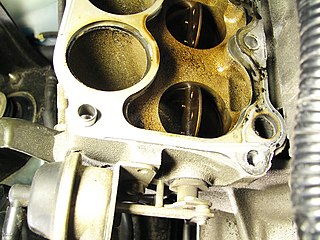
In internal combustion engines, a variable-length intake manifold (VLIM),variable intake manifold (VIM), or variable intake system (VIS) is an automobile internal combustion engine manifold technology. As the name implies, VLIM/VIM/VIS can vary the length of the intake tract in order to optimise power and torque across the range of engine speed operation, as well as to help provide better fuel efficiency. This effect is often achieved by having two separate intake ports, each controlled by a valve, that open two different manifolds – one with a short path that operates at full engine load, and another with a significantly longer path that operates at lower load. The first patent issued for a variable length intake manifold was published in 1958, US Patent US2835235 by Daimler Benz AG.

An overhead camshaft (OHC) engine is a piston engine in which the camshaft is located in the cylinder head above the combustion chamber. This contrasts with earlier overhead valve engines (OHV), where the camshaft is located below the combustion chamber in the engine block.
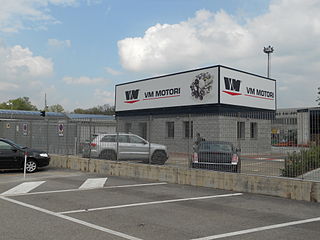
VM Motori S.p.A. is an Italian diesel engine manufacturing company which is wholly owned by Stellantis. VM headquarters and main production facilities are located in Cento, in Emilia-Romagna, Italy.
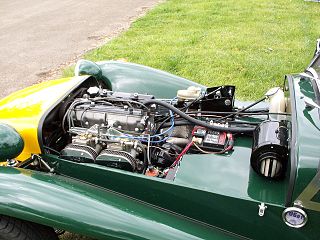
The Fiat Twin Cam is an advanced double overhead camshaft inline-four automobile engine produced from 1966 through 2000 as a Fiat/Lancia engine. Designed by ex Ferrari engineer Aurelio Lampredi, the engine was produced in a large number of displacements, ranging from 1.3 to 2.0 L and was used in Fiat, Lancia, Alfa Romeo, SEAT, FSO and Morgan cars. The Fiat Twin Cam engine has been widely used in motorsport and has been the most successful engine in the history of the World Rally Championship. Fiat and Lancia won a total of ten World Rally Championships for Manufacturers using engines based on the Lampredi Twin Cam engine. It was replaced by the Fiat "family B" Pratola Serra engine series.

The Renault 14 is a compact car produced by the French manufacturer Renault between 1976 and 1983. It was first shown in January 1976 with production beginning in June of that year.

The Peugeot 305 is a medium-sized car produced by the French automaker Peugeot from 1977 to 1989. It was offered as a four-door saloon, five-door estate, and as a three-door van derivative.
Multijet is Stellantis's term for its current common rail direct injection turbodiesel engine range. Most of the Fiat, Alfa Romeo, and Lancia range, as well as certain Chrysler, RAM Trucks, Jeep, and Maserati vehicles, are equipped with Multijet engines. Ownership of some Fiat Multijet designs is shared with General Motors as part of a settlement of the failed merger between the two auto conglomerates. The GM Powertrain Torino group in Turin, Italy, manages its interest in these engines. Some PSA Peugeot Citroën diesel engines are also rebadged JTD units, and vice versa. Fiat's common-rail diesel engine is also known as JTD, an initialism of Jet Turbo Diesel.

The Fiat 124 Sport Spider is a convertible sports car marketed by Fiat for model years 1966–1985. Designed by and manufactured at the Italian carrozzeria Pininfarina factory, the monocoque, front-engined, rear-drive Sport Spider debuted at the November 1966 Turin Auto Show with styling by Tom Tjaarda.

The Renault 20(R20) and Renault 30(R30) are two executive cars produced by the French automaker Renault between 1975 and 1984. The most upmarket and expensive Renaults of their time, the two cars were almost identical with regard to sheet metal and mechanicals; the R30 was the larger-engined and more expensive of the two. The two cars were easily distinguished between each other from their differing headlight configuration – the Renault 20 had two single rectangular headlights, whereas the Renault 30 had quadruple round headlights. The interior specifications differed substantially, however, with the Renault 30 having a higher specification in all models. Over 622,000 R20s and 145,000 R30s were produced in Sandouville near Le Havre, France.
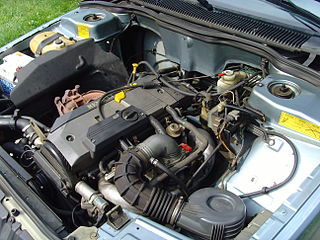
The Douvrin family is an all-aluminum inline-four automobile engine designed in the early 1970s and produced from 1977 to 1996 by Compagnie Française de Mécanique, a joint-venture between PSA and Renault located in the town of Douvrin in northern France. This engine is designed by the engineer Jean-Jacques His. It was produced in the same factory as the PRV V6, which also is sometimes known outside France as the "Douvrin" V6. The Douvrin engine is also referred to as the ZDJ/ZEJ engine by Peugeot, and as the J-type engine by Renault.

Executive car is a British term for a large car which is equivalent to the European E-segment and American full-size classifications. Executive cars are larger than compact executive cars, and smaller than luxury saloons / full-size luxury sedans.

The intake/inlet over exhaust, or "IOE" engine, known in the US as F-head, is a four-stroke internal combustion engine whose valvetrain comprises OHV inlet valves within the cylinder head and exhaust side-valves within the engine block.
The 8140 was a diesel engine made by Sofim for automobiles. Originally introduced as a swirl chamber, naturally aspirated diesel it was mostly used in commercial vehicles worldwide.

Meccanica Bessana Toys, was an Italian toy manufacturer that produced die-cast scale model cars during the 1960s and 1970s.

The Volkswagen Type 183, more commonly known as the Iltis, is a military vehicle built by Volkswagen for use by the German military. The Iltis was formerly built under licence in Canada by Bombardier Inc.

Designed by Aurelio Lampredi, the Fiat 124 engine first appeared in the all-new Fiat 124 in April 1966. The in-line four-cylinder engine comprised an iron block with an aluminium cylinder-head with pushrod actuated valves. The belt-driven design was ahead of its time when introduced. European production of the petrol versions ended with the Fiat 131 in 1984, but later diesel derivatives continued to be built until 1999. It did have a longer life in its twin-cam iteration, which continued in production until 2000. While originally of an overhead valve design, an overhead cam version was added to the facelifted 131 in 1981. The capacity was initially 1.2 L (1,197 cc), but eventually ranged between 1.2 and 1.9 L. There were also three SOHC diesel iterations of 1.4, 1.7, and 1.9 litres. The last versions of this engine to be built were the diesels. The 1.9 L (1,929 cc) direct-injected diesel version was the first direct-injection diesel to appear in a production passenger car, the Fiat Croma Turbo D i.d.

